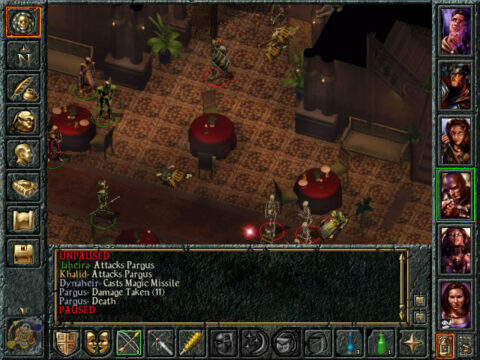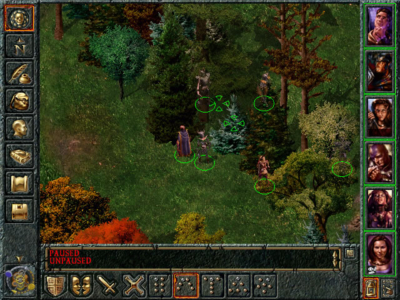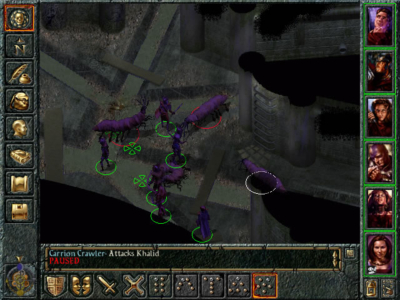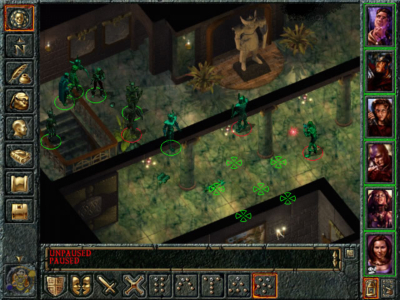
Baldur’s Gate
Written by: Stoo
Date posted: May 29, 2009
- Genre: RPG
- Developed by: Bioware
- Published by: Black Isle Studios/Interplay
- Year released: 1998
- Our score: 8
If you look at our content sorted by genre, you’ll notice that the RPG section is looking rather thin. Which is a little embarrassing as it’s supposed to be one of my specialities and god knows Rik has put in enough hours on his own specialities like racing. Also, of what we do have, a few games are action-hybrids, then a couple more are in the japanese-console style. It appears i’ve just never actually played many of what we might call “traditional” RPGs.
In my defense, I could argue that some of the older ones can be difficult to get to grips with – clunky interface, unforgiving combat. Also though this kind of game takes a major time commitment; weeks of your life devoted to questing, stat-grinding and goblin slaying. That’s why I’d say it’s harder to give a fair assessment of an old RPG than, say, an old first person shooter. However, it’s about time I stopped making excuses and produced some content!
There’s a couple of reasons Baldur’s Gate struck me as a great choice with which to reinforce our RPG section. For one, it’s an adaptation of the famous Dungeons and Dragons. Which is of course the original pen-and-paper fantasy roleplaying game, dating back to the 1970s and and ancestor of all the computer versions we have today. There have been plenty of other adaptations of D&D of course, but something from the late 90s strikes me as a good balance between the criteria of “old game” and “reasonably accessible”. Also it was developed by Bioware, still respected names in the genre with the recent Mass Effect to their credit.
The specific setting meanwhile is the Forgotten Realms, a traditional medieval-fantasy world and apparently one of the most popular in D&D. So try not to roll your eyes at the elves-and-castles stuff – again this is where it all started in any sort of gaming context. BG casts you as a young person of uncertain origins, raised by a powerful mage. Your life has been a quiet one, under the tutelage of your guardian, living amongst the scholars in the fortress of Candlekeep. However the carefree existence is quickly shattered – it turns out you’re not safe there, people want you dead. Your guardian won’t tell you why exactly, but decides it’s time to leave. Except your journey has barely started when some spiky-armoured villain attacks, and kills your guardian while you run like hell.
Which isn’t the most heroic start really; homeless and wimpy, it’s a humble beginnings. Then again, that’s how all great heroes start off perhaps. From here you set out to find out why spiky guy wants you dead, and what exactly your own history is. It’s a long journey to get there, though. Initially you find yourself helping the people of the Sword Coast, investigating a recent increase in bandit activity and a shortage of iron. This leads to conspiracies and shadowy organisations covertly manipulating the situation. Tracking them leads you to the mighty city of Baldur’s Gate itself, your arch-nemesis and hopefully some answers.
The game’s engine is an isometric-view affair. The graphics are 2D, but arranged to look like a 3D world seen from a vantage point looking down and across (as opposed to a purely top-down view). This was actually a time when 3D graphics were a rising force, particularly for strategy games using a similar overhead-view. They were were still boxy and spartan though, and wouldn’t have done so well here. Instead BG’s artwork is well drawn and richly detailed. Unspectacular in a modern light, for sure, but still really quite easy on the eye. The character sprites also are well animated and special effects for spells are up to the task.
One of my few complaints is, thanks to the 2D approach it’s sometimes annoying trying to find doors on buildings facing away from your view – obviously no rotating that view is possible. Oh and overall it’s stuck in a slightly muddy 640×480, although I think fan patches have improved that, and also you can play in a window. Oh and the pre-rendered cutscenes have aged badly. All minor grumbles though and on another positive note the mouse interface is slick, user friendly and entirely mouse-driven.
Anyway though the first task though is to generate your own hero according to your preferences – equivalent of rolling your character in the pen and paper game. That means choosing a race – the usual fantasy stuff, like elf or human or hobbit. Also you must pick a class. Mostly the options are pretty obvious – warriors batter things, mages fling spells around, thieves pick locks, clerics are healing\defensive spellcasters. There are some more advanced options too like dual-classing, although i never ventured into that. The one annoying bit is the virtual dice-rolling determine your stats like strength and intelligence. Since these are important in determining how well you can swing a sword, or cast a spell, you have to basically sit there and roll random numbers until you get optimum results, or be penalised with a lesser hero. It was a once-common feature I’m glad to see having mostly died off.
This isn’t a game of lone heroics though; along the way though you’ll pick up to five adventurers to join you. In fact there are over a dozen of them out there, giving you quite a choice, and since they represent all the classes you can create a balanced party. Each is meant to be distinct character in their own right; unfortunately don’t have a lot of depth to them, but they do still help bring the game alive. They sometimes have their own minor agendas, such as having a particular quest they wish to follow. Also they throw in comments along the way, complaining when injured or remarking on your leadership. They might even chat with each other, or start arguing if they don’t get along. Even if the voice acting is kind of goofy sometimes, with their distinct personalities you can become quite attached to some of them. Some are haughty, some nervous, others just mildly crazy. Watch out for Minsc the ranger and his cries of STICKY WHEEL GETS THE KICK. Silly enough to make you think Black Isle had their tongue in cheek, but definitely likeable.
As a sidenote, they’re not all good guys – D&D uses an alignment system with various combinations of good\evil and chaotic\lawful with neutral positions between both. Interestingly you can choose evil for yourself, and although it doesn’t alter the overall course of the game a lot you are often given opportunities to be a bastard. An example might be killing a captured nymph for loot instead of setting her free. I never investigated that side of things much though, so I don’t know if any benefits of evil counter the downsides like people not wanting to do business with you. Note tho that thievery isn’t an “evil” thing according to the game, being apparently more a matter of chaotic\lawful. So knock yourself out taking people’s stuff, just don’t get caught.
The opening section ofthe game takes part in Candlekeep, before that dramatic opener, and this serves as the tutorial (hint: there’s a simulated combat sequence that’s worth paying attention to). Afterwards you’re thrown out into the wider world, with some pointers on where to go next and continue the story, but the freedom to randomly explore if you prefer. The Sword Coast is represented with many discrete areas, joined by a map overview. If you cross a known area and click to walk off the boundary, you’ll unlock the one next to it. Then on subsequent visits you can go there directly.
There’s a lot of generic open wilderness early on, forest or rocky waste. As mentioned it’s an attractive environment to explore; in fact it’s quite soothing to stroll along a little stream in a forest clearing, taking in the scenery. I almost wished i could have stopped to fish or have some lunch. (Okay it’s not so soothing when gnolls or bandits rudely interrupt you, requiring you to batter them for their transgression.) There are day and night cycles too, along with some basic weather effects, to make it all feel that little bit more convincing.
Unfortunately though these areas can feel empty and a little monotonous after a while, often lacking distinguishing features or landmarks. Then again it’s not obligatory to fully explore them all; just charge across the map if you get bored. (watch out for giant spiders).
You encounter a few towns along the way too, which are comprehensively featured with houses, manors and shops. Interactions with “generic peasant” characters are very limited, but then they usually are in these games (how do you make a couple of hundred generic peasants interesting?). There are also plenty of more individual and well-written characters who are linked to the main storyline or will give you side-quests to do.
Towards the end of the game you reach the main city, a sprawling affair of nine zones linked together plus obligatory sewers. You’ll find plenty to do there – chasing monsters loose in the docks, or helping some merchant who’s son was last seen straying into the temple of a sea goddess. Also just about every building in the game can be entered; whether you have legitimate business in there or not.
There are of course dungeons also, which is kind of thematically sensible (but no dragons alas. You’ll have to settle for Basilisks). You don’t spend all your time in such places; after all this isn’t what’s known as a Dungeon Crawler (the Icewind Dale series used the same engine for more dungeon-heavy antics). However there are still several major sessions of heading beneath the earth to slay ghouls and seek glory. They’re dangerous places, full of bandits, gnolls and dopplegangers. Also tho they can be full of traps, which is where a thief can make themselves extra useful. With nowhere to safely rest, hitting the “night’s sleep” button to rejuvenated your heroes might result in being ambushed. In other words, they form the periods of sustained challenge in between more casual exploring or minor quests.
A grumble back on the technical side though: character route finding is occasionally frustrating. For example if you click a location a long way off, characters might take a few detours along the way. The infamous Narrator line “you must gather your party before venturing forth” came up many a time for me, when five of us were ready to leave on the edge of map and the sixth was investigating a tree. Also if you have the full team selected and click to interact with a person or object, instead of the nearest character doing it the lead character will mill around trying to get there, probably with the other five or a wall getting in their way.
Anyway though I mention slaying ghouls – that sort of thing will of course occupy much of your time. Combat is all in real-time, like the rest of the game, although you can hand out orders while paused. At first the difficulty can seem pretty steep; in fact my first attempt at the game saw my puny warrior being chewed by mangy wolves. Then getting chewed some more when he tried to rest. As a helpful suggestion, it seemed to help a lot to have a few characters competent with bows; actually I have a sneaking suspicion they’re a bit overpowered. With a decently balanced party i quickly found lesser fights become reasonably easy in an “everyone attaaack!” style.
For tougher foes though some tactical thought is required. Also you’ll probably be punching pause quite a lot to co-ordinate the efforts of six heroes, who each have a different role to play in the fight. So there can often be several things going on at once needing your attention. Warriors need to keep the pressure up on their targets. Thieves might be hiding waiting for a chance to backstab. Someone might be in need of healing, because of an archer making your life miserable. Also squishy mages need to be staying away from the front line and letting rip with spells without getting skewered.
Actually I found spellcasters handle a bit differently to other RPGs. They have masses of spells available as usual; all kinds of tricks to harm the enemies, debilitate them and heal and enhance your own team. However unlike most other games you can’t just fire off any spell you like until your mana or spellpoints run out. Rather, only a limited number of spells can be ready for use at any one time – essentially you have a bank of “memorised” spells from the wider pool of “known” spell. Any can be memorised more than once but that uses another slot. This requires some forward planning, in terms of thinking what spells you’re most likely to need in a situation. Resetting or rearranging readied spells requires a night’s safe rest.
Which sounds a bit fiddly, and often in fights against standard mooks i found my casters hanging around the rear not doing much, as i didn’t want to waste their spells, especially at low levels when the memory bank is limited. However they can be devastating when put to use – a challenging fight is greatly eased if one foe is staggering around blind, another fried with lightning and your own barbarian is running around at double speed. The flipside is that shutting down enemy wizards is a must – especially when they have friends trying to distract you.
So I’ve certainly had some GODAMMIT moments when my entire team was wandering around uselessly under the effect of a confusion spell, whilst an ogre stamped up on down on their heads. But that’s just a challenge to try harder next time, and it’s satisfying when you get this all right, leaving a pile of mangled dopplegangers and smashed skeletons at your feet. Or a wizard slumped over the remains of his burly bodyguards (Time to loot him for shiny treasures!). I have to admit that personally I relied a lot on luck, fire arrows and blind spells. I think though that that those of you who take the time to master combat will find it rewarding.
Another sidenote: combat mechanics are all described in the same terms as the tabletop game. So a sword will be described as doing “2d4+1 damage”, i.e. 3-9 points, because originally you would have rolled two four-sided dice. Also armour has a numerical rating as usual for RPGs but a lower score is better. Meanwhile an important character stat is arcane-sounding THAC0, which represents the chance of an attack hitting someone with an armour class of zero. None of this is rocket science really though, you might just want to sit and read the manual a bit. Or, more likely unless you have an original release, sit and read the pdf.
On another RPG detail – as is traditional your adventurers gain experience points for killing enemies or completing quests. Gain enough points and a character goes up a level with a corresponding boost to general capabilities. Interestingly the game is comparatively sparing with its “level-ups” – I finished with my heroes around level 7 ish, which might feel odd if you’re more used to RPGs that have you hammering through the ranks. Still there is a definite feel of being more powerful than when you started, which is the point.
Anyway we’re not just here to batter things for the hell of it. Well okay you can if you want. Random exploration and the various side-quests are a great way to gain loot or experience, or just plain pass half an hour. However there is that main narrative to be getting on with too. You often can put it to one side whenever you like, but you’ll be coming back to it sooner or later.
That story itself represents a half-decent effort at writing. It’s better than some nonsense about questing for magic gems that some RPGs might throw at you anyway. Unravelling the conspiracy is satisfying, with each step in taking apart the bandits and shadowy trading organisations taking you closer to your final nemesis. Also it manages to step up the excitement towards the end, with some unexpected twists.
The main weakness is that the whole “find out your true nature” theme isn’t quite what it could have been. It isn’t built on enough along the way, apart from some vague talk of dreams. So at times I felt more like just a general freelance adventurer with a vague long-term agenda. Then the final reveal, having not been properly set up, felt like it came out of nowhere. I suppose also I’d have liked to see the supporting characters play more of a part. They could have been integrated into the story, or had better developed subplots of their own. So the end result is a lack of the personal stake I might have hoped for (and that,for example, Final Fantasy 7 did a lot better).
Okay so, summary time. I came to this game hoping to write a glowing writeup, as it seems to be regarded of the pillars of traditional RPG fare on the windows-era PC. As it happens though, you can tell I have some reservations. Somewhere along the hours of roaming forests in the first half of the game, wondering down mines to kill a wizard then repeating the process, I didn’t pick up the momentum I was hoping for. It just didn’t compell me to stay up till 1am on a work night, the way a truly essential game does.
That said, there’s still a lot that Baldur’s Gate does right. It’s aged well, the combat system is detailed and challenging, and there’s masses of questing fun on offer. You could certainly spend some enjoyable evenings in such adventures as chasing basilisks, or geting caught up in a feud between necromancers, or committing wholesale goblin slaughter in pursuit of treasure. And again even if the story lacks, well.. it’s making more of an effort than much of the competition used to. So it’s a solidly enjoyable RPG experience.
I agonised for a long time as to whether “solidly enjoyable” translates to a 3.5 or 4 points out of 5 on our score-o-meter (in fact numerical scoring has always been tricky for me). For now I’m going to give it the benefit of the doubt – consider this provisional. I hear the sequel was an all-round improvement, and the more recent Neverwinter Nights would also serve as a useful point of comparison. In any case though, it’s a welcome reinforcement to our RPG selection and worth a look for any fan of chainmail and questing.





 Posts
Posts